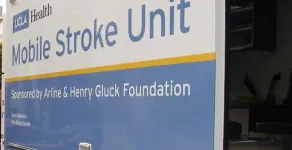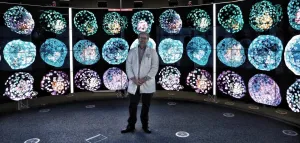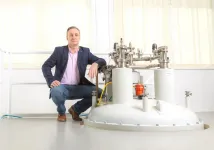INFORMATION:
UCLA's Mobile Stroke Unit is staffed by a vascular neurologist, either in person or by telemedicine, a firefighter paramedic, a critical care nurse and a CT technologist. After diagnosis, brain and life-saving therapies are delivered to the patients faster than ever before.
It currently operates in three geographic sites: the Western Site (Santa Monica, Beverly Hills, as well as patients transported from the Malibu to the city of Santa Monica), the Southern Site (Hawaiian Gardens, Signal Hill, Long Beach, Lakewood, La Mirada, Cerritos, Artesia, Bellflower, Paramount, unincorporated Whittier) and the most recently launched South Bay Site (Torrance, Hawthorne, Lawndale, Gardena, Carson, East Central LA, with future plans to include participating Beach City fire departments and Compton Fire).
'Time lost is brain lost'
Study finds mobile stroke units improve outcomes and lessen rates of disability in stroke patients.
2021-03-17
(Press-News.org) A new study involving UCLA researchers finds that mobile stroke units (MSUs) - state-of-the-art ambulances built to provide stroke patients with emergency neurological diagnosis and treatment prior to hospital arrival -- improve patient outcomes and lessen the chance for disability by delivering care faster than standard stroke care.
The UCLA Mobile Stroke Unit serves as a shared regional resource of LA County EMS Provider Agencies, taking patients to 15 different stroke center hospitals within 3 regions in Los Angeles County. The MSU carries a CT scanner that can directly image the brain and blood vessels in the field. UCLA was one of seven national mobile stroke unit programs to participate in the clinical trial, which was presented March 17 at the International Stroke Conference.
Dr. May Nour, the UCLA MSU program's medical director and a lead author on the study, said that she is very pleased that the study findings reflect the positive experience that she and her colleagues have been witnessing while treating patients in the field.
"Stroke is one of the golden-hour emergencies in which the swift timing of conclusive diagnosis and treatment dramatically impacts patient outcome and their chances of meaningful recovery," Dr. Nour said. "We set out a few years ago to quantify the magnitude of benefit of mobile stroke unit pre-hospital care for our patients. We are proud to have participated in this pivotal trial. Today is a momentous day for the citizens of Los Angeles County."
In October, Stephanie Wimberly, 40, of South Los Angeles, was at her dentist in Hawthorne when she experienced a stroke.
"I honestly believe that if it wasn't for the UCLA Mobile Stroke Unit, I wouldn't be alive today," she said. "Dr. Nour saved my life."
UCLA's was the first mobile stroke unit launched in the California and in the western third of the United States. There are 20 mobile stroke unit sites throughout the United States. Clinical operations began in September of 2017 and have been supported by the Arline and Henry Gluck Foundation as well as Measure B funds from the Los Angeles County Board of Supervisors, which Supervisor Janice Hahn was instrumental in making available.
"The (UCLA) Mobile Stroke Unit is saving lives and preventing patients from experiencing debilitating brain damage after a stroke," said Supervisor Hahn. "Mobile stroke units are the future of stroke treatment and I envision a day when we have enough of these units on the road to treat every stroke patient in LA County."
The program currently provides hyper acute stroke care in the field for patients 6 days per week, 12 hours per day.
The study compared tissue plasminogen activator (tPA)-eligible patients managed by MSUs vs standard ambulance/emergency room care. It enrolled 1,517 patients with suspected acute ischemic stroke within 4.5 hours of experiencing symptoms. This included 617 patients in the MSU group and 430 in the standard care group who qualified for tPA. Of the tPA eligible patients, 97% received it in the MSU versus 80% with standard care.
Time from onset of symptoms until tPA treatment was shorter in the MSU group with a median time of 72 minutes versus 108 minutes in the standard treatment group. Thirty-three percent of MSU patients were treated within 60 minutes, compared to just 3% of SM patients.
The research concluded that the MSU patients had better outcomes and experienced much less disability, likely because the MSU patients received treatment faster.
"This convincing demonstration of the benefits of MSU care will support the incorporation of mobile stroke units into emergency medical systems throughout the country," said Jeffrey Saver, MD, the director of the UCLA Comprehensive Stroke and Vascular Neurology Program. He added, "A new era in acute stroke has arrived."
Research from UCLA has shown that 2 million brain cells are injured every minute in a stroke, supporting the American Heart/Stroke Association's public message that, "Time lost is brain lost in acute stroke,'' Dr. Saver said.
"The study results demonstrate that for every 100 patients treated with a mobile stroke unit rather than standard care later in the emergency department, 27 will have less final disability, including 11 more who will be disability free," Dr. Nour added. "With these results, and keeping our patients and their families in the forefront of our minds, we are hopeful that this data provides initiative for expanding the mobile stroke unit pilot in our county to include a fleet of MSUs to serve all of the citizens of Los Angeles County in their greatest time of need."
ELSE PRESS RELEASES FROM THIS DATE:
Losing rivers
2021-03-17
Water is an ephemeral thing. It can emerge from an isolated spring, as if by magic, to birth a babbling brook. It can also course through a mighty river, seeping into the soil until all that remains downstream is a shady arroyo, the nearby trees offering the only hint of where the water has gone.
The interplay between surface water and groundwater is often overlooked by those who use this vital resource due to the difficulty of studying it. Assistant professors Scott Jasechko and Debra Perrone, of UC Santa Barbara, and their colleagues leveraged their enormous ...
Aspirin use may decrease ventilation, ICU admission and death in COVID-19 patients
2021-03-17
George Washington University researchers found low dose aspirin may reduce the need for mechanical ventilation, ICU admission and in-hospital mortality in hospitalized COVID-19 patients. Final results indicating the lung protective effects of aspirin were published today in Anesthesia & Analgesia.
"As we learned about the connection between blood clots and COVID-19, we knew that aspirin - used to prevent stroke and heart attack - could be important for COVID-19 patients," Jonathan Chow, MD, assistant professor of anesthesiology and critical care medicine and director of the Critical Care Anesthesiology ...
Study finds plants would grow well in solar cell greenhouses
2021-03-17
A recent study shows that lettuce can be grown in greenhouses that filter out wavelengths of light used to generate solar power, demonstrating the feasibility of using see-through solar panels in greenhouses to generate electricity.
"We were a little surprised - there was no real reduction in plant growth or health," says Heike Sederoff, co-corresponding author of the study and a professor of plant biology at North Carolina State University. "It means the idea of integrating transparent solar cells into greenhouses can be done."
Because plants do not use all of the wavelengths of light for photosynthesis, researchers have explored the idea of creating semi-transparent organic solar ...
Scientists create model of an early human embryo from skin cells
2021-03-17
AUSTRALIAN - LED INTERNATIONAL RESEARCH TEAM GENERATES THE FIRST MODEL OF EARLY HUMAN EMBRYOS FROM SKIN CELLS
In a discovery that will revolutionize research into the causes of early miscarriage, infertility and the study of early human development - an international team of scientists led by Monash University in Melbourne, Australia has generated a model of a human embryo from skin cells.
The team, led by Professor Jose Polo, has successfully reprogrammed these fibroblasts or skin cells into a 3-dimensional cellular structure that is morphologically and molecularly similar to human blastocysts. Called iBlastoids, these can be used to model the biology of ...
Racial/ethnic disparities in very preterm, preterm birth before, during COVID-19 pandemic
2021-03-17
What The Study Did: Racial and ethnic disparities in very preterm birth and preterm birth among 8,026 women were similar during the first wave of the COVID-19 pandemic in New York City compared with the same period the year prior in this observational study.
Authors: Teresa Janevic, Ph.D., M.P.H., of the Icahn School of Medicine at Mount Sinai in New York, is the corresponding author.
To access the embargoed study: Visit our For The Media website at this link https://media.jamanetwork.com/
(doi:10.1001/jamanetworkopen.2021.1816)
Editor's Note: The article includes conflict of interest and funding/support disclosures. Please see the article ...
AI method can detect precursors to cervical cancer
2021-03-17
Using artificial intelligence and mobile digital microscopy, researchers hope to create screening tools that can detect precursors to cervical cancer in women in resource-limited settings. A study led by researchers at Karolinska Institutet in Sweden now shows that AI screenings of pap smears carried out with portable scanners were comparable to analyses done by pathologists. The results are published in the journal JAMA Network Open.
"Our method enables us to more effectively discover and treat precursors to cervical cancer, especially in low-income countries, where there is a serious lack of skilled pathologists ...
Common antibiotic can safely be given to most surgery patients despite penicillin allergy
2021-03-17
BOSTON - Most surgical patients with a history of penicillin allergy can safely be given the guideline-recommended antibiotic cefazolin to prevent infection instead of several penicillin alternatives that are less effective and more expensive, according to a study conducted by Massachusetts General Hospital (MGH), the University of Colorado Anschutz Medical Campus and the University of Porto in Portugal. The researchers reported in JAMA Surgery that the frequency of allergies to both penicillins and cefazolin was so small that most patients should receive cefazolin regardless of their allergy history.
"Under current practice, ...
Magnetism meets topology on a superconductor's surface
2021-03-17
UPTON, NY--Electrons in a solid occupy distinct energy bands separated by gaps. Energy band gaps are an electronic "no man's land," an energy range where no electrons are allowed. Now, scientists studying a compound containing iron, tellurium, and selenium have found that an energy band gap opens at a point where two allowed energy bands intersect on the material's surface. They observed this unexpected electronic behavior when they cooled the material and probed its electronic structure with laser light. Their findings, reported in the Proceedings of the National Academy of Sciences, could have implications for future quantum information ...
For hip fracture patients, hospital reimbursements rising faster than surgeon reimbursements
2021-03-17
March 17, 2021 - In recent years, hospital charges and Medicare payments for patients with hip fractures have increased much more rapidly than charges and payments for orthopaedic surgeons, reports a study in the Journal of Orthopaedic Trauma. The journal is published in the Lippincott portfolio by Wolters Kluwer.
The gap in Medicare reimbursements to hospitals compared to surgeons widened substantially in the last decade - even as patient outcomes improved and healthcare resource use decreased, according to a new analysis by Brian Werner, MD, and colleagues of UVA Health, Charlottesville, Va. "The results confirm our hypothesis that hospital charges and payments contribute significantly more to the increasing cost of treating a hip fracture patient than surgeon ...
'We marry disorder with order'
2021-03-17
He and his research group have found a way to more precisely determine the properties of these materials, because they can better account for the underlying disorder. Their article has been designated "ACS Editors' Choice" by the editors of the American Chemical Society journals, who recognise the "importance to the global scientific community" of the Leipzig researchers' work and see it as a breakthrough in the accurate description of phase transition phenomena in disordered porous materials.
In mesoporous materials, the pore openings are far smaller than in a normal sponge: their diameters range from 2 to 50 nanometres and are invisible to the naked eye. Nevertheless, they have a number of interesting properties, including with ...
LAST 30 PRESS RELEASES:
Sleeping in on weekends may help boost teens’ mental health
Study: Teens use cellphones for an hour a day at school
After more than two years of war, Palestinian children are hungry, denied education and “like the living dead”
The untold story of life with Prader-Willi syndrome - according to the siblings who live it
How the parasite that ‘gave up sex’ found more hosts – and why its victory won’t last
When is it time to jump? The boiling frog problem of AI use in physics education
Twitter data reveals partisan divide in understanding why pollen season's getting worse
AI is quick but risky for updating old software
Revolutionizing biosecurity: new multi-omics framework to transform invasive species management
From ancient herb to modern medicine: new review unveils the multi-targeted healing potential of Borago officinalis
Building a global scientific community: Biological Diversity Journal announces dual recruitment of Editorial Board and Youth Editorial Board members
Microbes that break down antibiotics help protect ecosystems under drug pollution
Smart biochar that remembers pollutants offers a new way to clean water and recycle biomass
Rice genes matter more than domestication in shaping plant microbiomes
Ticking time bomb: Some farmers report as many as 70 tick encounters over a 6-month period
Turning garden and crop waste into plastics
Scientists discover ‘platypus galaxies’ in the early universe
Seeing thyroid cancer in a new light: when AI meets label-free imaging in the operating room
Neutrophil-to-lymphocyte ratio may aid risk stratification in depressive disorder
2026 Seismological Society of America Annual Meeting
AI-powered ECG analysis offers promising path for early detection of chronic obstructive pulmonary disease, says Mount Sinai researchers
GIMM uncovers flaws in lab-grown heart cells and paves the way for improved treatments
Cracking the evolutionary code of sleep
Medications could help the aging brain cope with surgery, memory impairment
Back pain linked to worse sleep years later in men over 65, according to study
CDC urges ‘shared decision-making’ on some childhood vaccines; many unclear about what that means
New research finds that an ‘equal treatment’ approach to economic opportunity advertising can backfire
Researchers create shape-shifting, self-navigating microparticles
Science army mobilizes to map US soil microbiome
Researchers develop new tools to turn grain crops into biosensors
[Press-News.org] 'Time lost is brain lost'Study finds mobile stroke units improve outcomes and lessen rates of disability in stroke patients.




